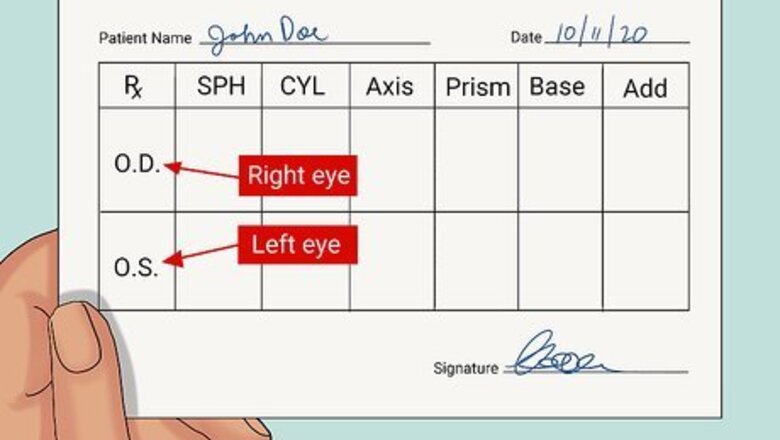
views
Understanding the Terminology
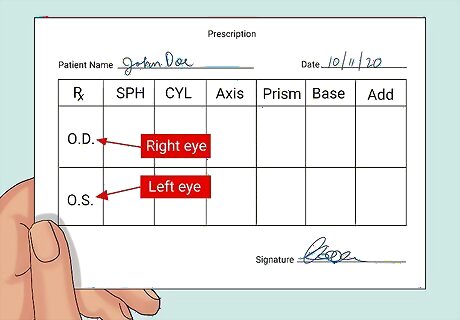
Look for O.D. or O.S. to determine which eye is which. Most prescriptions will include at least two rows of numbers, one labelled “O.D.” and the other labelled “O.S.” O.D. is short for “oculus dexter,” which is Latin for “right eye.” O.S. is short for “oculus sinister,” which is Latin for “left eye.” Occasionally, you may see a prescription with a line labeled O.U., or oculus uterque, for both eyes. Some prescriptions may use R.E. and L.E., or just “right” and “left,” instead of O.D. and O.S.
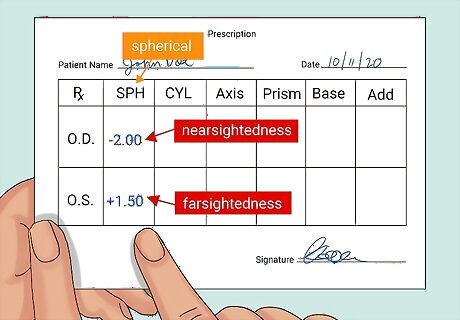
Check the “SPH” column if you are nearsighted or farsighted. SPH stands for “spherical.” The numbers in this column indicate how strong your lens must be to correct for nearsightedness or farsightedness. The numbers represent diopters, a unit of measurement used to describe the corrective strength of a lens. A negative number, such as -2.00, indicates nearsightedness (difficulty seeing far away). A positive number, like +1.50, indicates farsightedness (difficulty seeing up close).
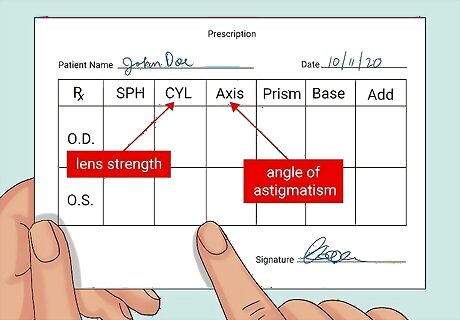
Read the “CYL” and “Axis” columns to find astigmatism corrections. Astigmatism is a blurring of the vision caused by an irregularity of the lens or cornea. The lens strength needed to correct astigmatism can be found in the CYL (“cylindrical”) column. The axis column contains a number that corresponds to the angle of your astigmatism. The numbers in the CYL column will be either positive (e.g., +3.00) or negative (e.g., -0.50) depending on whether your astigmatism corresponds to farsightedness or nearsightedness. On some prescriptions, there may be no axis column. Instead, the axis may be preceded by an x and written right after the cylindrical measurement (e.g., +2.50 x30).
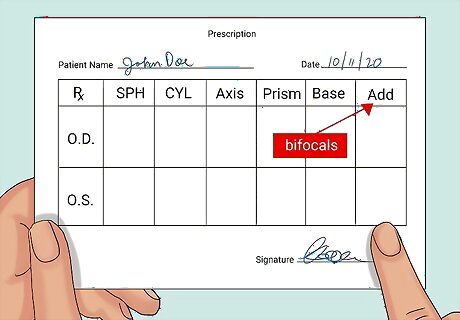
Check for an “Add” row if you need bifocals. If your eyes need both near vision and distance vision correction, your prescription will have two rows of spherical corrections. Many bifocal prescriptions list near vision corrections in a row called “Add.” Others will separate near and distance vision corrections into N.V. and D.V. rows, with “add” written in to indicate that bifocals are needed.
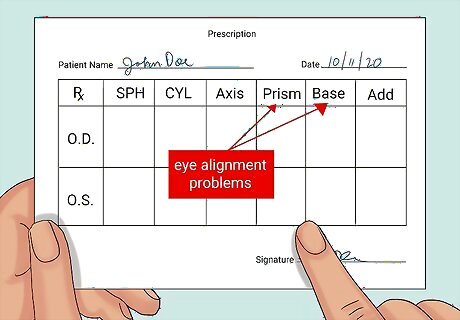
Find eye alignment corrections in the “Prism” and “Base” columns. These corrections are for eye alignment problems, such as strabismus, crossed eyes, or “lazy eye." Prism correction is written in fractional “prism diopters” (e.g., 0.5 or ½). The base column indicates the location of the prism on the lens, i.e. “up,” “down,” “in,” or “out.” Most prescriptions do not include prism or base information, as these types of corrections are not particularly common. If your prescription has no “Prism” column, your prism diopter measurement may be labeled “p.d.” or preceded by a triangle. Base position may be written as BU (“base up”), BD (“base down”), BI (“base in”), or BO (“base out”).
Finding out Your Pupillary Distance
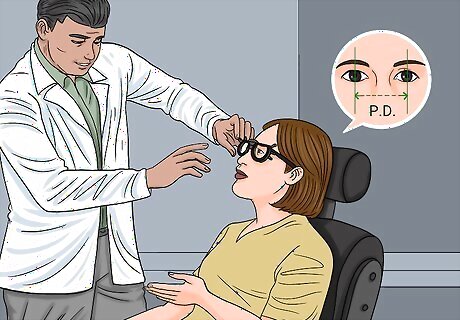
Ask your eye doctor for your pupillary distance if you don’t mind paying. Your pupillary distance (P.D.) is the horizontal distance between your pupils, in millimeters. The optician who crafts your lenses needs this information in order to position the optical center of your glasses correctly. While your vision provider is not required by law to release your P.D. in most places, some may be willing to do so, either free of charge or for a fee. If your vision provider charges a fee to release your pupillary distance, you may be able to get a refund from some online retailers.
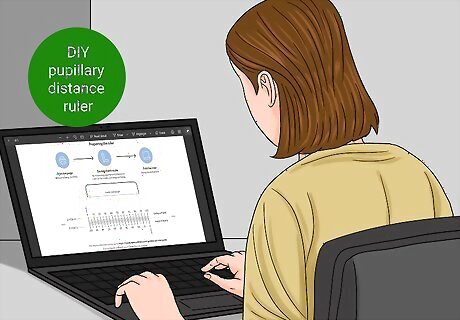
Buy or print out a pupillary distance ruler for a simple DIY measurement. If your eye doctor won’t release your pupillary distance, you can measure it yourself with a P.D. ruler. Buy a straight edge or digital P.D. ruler online, or download a free template to print and cut out. You can also measure your P.D. with a regular ruler using the metric edge.
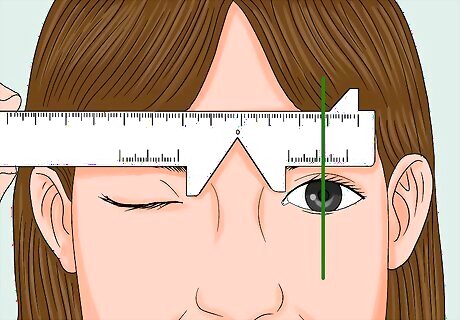
Measure your own pupillary distance with a P.D. ruler. To measure your P.D., stand in front of a mirror and place the notch on the ruler (marked with a 0) over the bridge of your nose. Close your left eye, and read the number on the ruler directly over your right pupil. Reverse the process to find the measurement for your left pupil. Add the two numbers together for the total distance. The average P.D. for adults is 54-74 mm, and 43-54 mm for a child. If your P.D. results are far outside that range, you may have measured incorrectly. Measure your P.D. 3-4 times to ensure accurate results. If you use a regular ruler, place the 0 mm mark directly over your right pupil, and measure from there to the number directly over your left pupil.
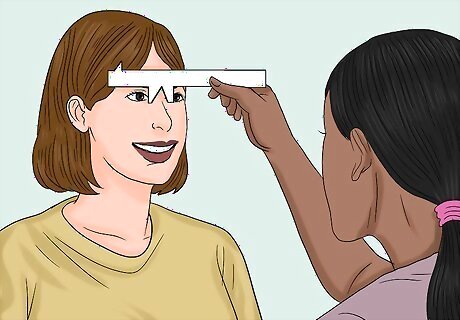
Get a friend to measure your P.D. If you’d rather not take the measurement yourself, ask a friend to help you. Have them crouch just below your field of vision, and focus on something 10-12 ft. (3-3.7 m) away while they take the measurement with a P.D. ruler. Keep your eyes still and don’t look at your friend while they take the measurement. Moving your eyes or focusing on your friend will skew your results.
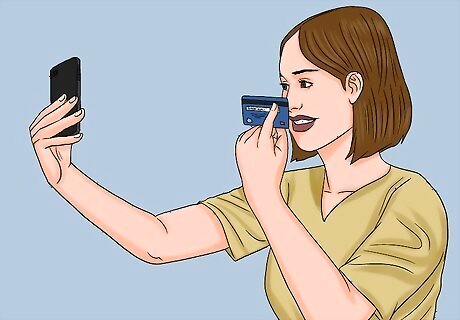
Use a pupillary distance app for a quick and easy digital measurement. If you have a smartphone with a camera, you can get a reading of your pupillary distance with an app like PD Meter by GlassifyMe. Many online glasses retailers, such as Warby Parker and FinestGlasses.com, also offer free P.D. measurement tools that allow you to upload photos or use your webcam to determine your P.D. Most of these tools require you to include an object for scale in the photo, usually a credit card with the signature side facing the camera. Note that this method may produce inaccurate results, since it forces you to focus on a close-up target (your phone camera or computer screen). Your pupillary distance becomes narrower when you are looking at something close-up.
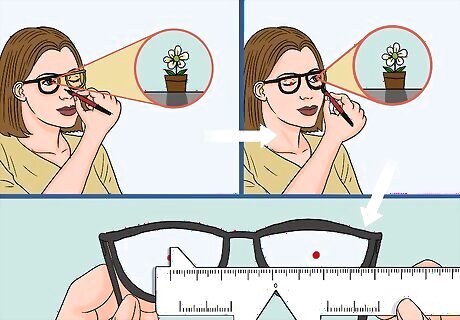
Measure your P.D. more accurately with focus points on your glasses. With your current pair of glasses on, focus on an object in the distance, at least 20 ft (6 meters) away. Close your left eye, and use a washable felt-tipped marker to place a dot on your right lens so that it directly covers the object you are focusing on. Close your right eye, and repeat on your left lens. Then, measure the distance between the two dots in millimeters. If you are trying to find your P.D. for near vision glasses, focus on something close-up (like a book at normal reading distance) instead.


















Comments
0 comment